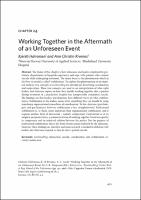Chapter 24 Working Together in the Aftermath of an Unforeseen Event
Author(s)
Halvorsen, Kjersti
Rivenes, Ann Christin
Language
EnglishAbstract
"The frame of this chapter is how clinicians and leaders employed in psychiatric
departments in hospitals experience and cope with patients who commit
suicide while undergoing treatment. The major focus is the phenomenon which in
the Bow-tie model is called “stabilization”. To explore this phenomenon in an empirical
analysis, two concepts of samhandling are introduced, these being coordination
and cooperation. These two concepts are used in an interpretation of what eight
leaders and clinicians report on how they handle working together after a patient
during treatment in a psychiatric hospital has unexpectedly committed suicide.
The findings are that leaders and clinicians have different views on what stabilization
is. Stabilization to the leaders seems to be something they can handle by using
mandatory organizational procedures of coordination. To the clinicians (psychologists
and psychiatrists) however, stabilization is less straightforward. Professional
stabilization is, to them, more important than organizational stabilization, and it
requires another form of interaction – namely, cooperation. Cooperation is, in its
simplest and purest form, a symmetrical way of working together, based on equality
in competence and an unforced relation between the parties. For the purpose of
professional stabilization, this is the form of interaction preferred by the clinicians.
However, these findings are tentative and more research is needed to elaborate why
leaders and clinicians respond as they do after a patient suicide."
Keywords
Samhandling; interaction; suicide; coordination; risk; stabilization; recovery; unforeseenDOI
10.23865/noasp.36.ch24OCN
1076753520Publisher website
https://www.cappelendamm.no/Publication date and place
Oslo, 2018Classification
Society and Social Sciences
Warfare and defence
Military and defence strategy


 Download
Download